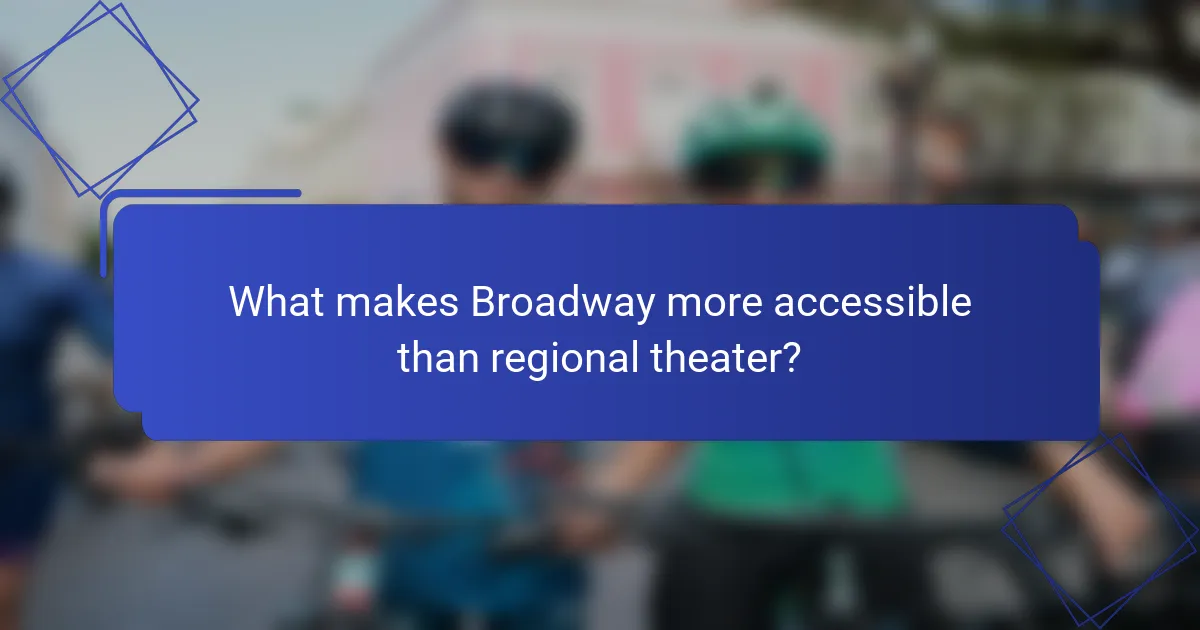The contrast between regional theater and Broadway highlights differences in popularity, accessibility, and overall experience. While regional theater fosters a strong local connection, Broadway stands out as a globally recognized hub for high-quality productions. Accessibility to Broadway is enhanced by its prime location and extensive transportation options, offering audiences a convenient way to enjoy performances. In terms of experience, Broadway showcases larger productions with renowned talent, whereas regional theater emphasizes intimacy and community engagement.

How does regional theater compare to Broadway in popularity?
Regional theater generally enjoys a strong local following, while Broadway is recognized globally as a premier destination for theatrical productions. The popularity of each varies based on factors such as location, audience engagement, and production quality.
Broadway’s global recognition
Broadway is synonymous with high-quality theater and attracts audiences from around the world. Its productions often feature well-known actors and elaborate sets, contributing to its status as a cultural landmark in New York City.
The global recognition of Broadway allows it to command higher ticket prices, with some shows selling for hundreds of dollars. This fame also leads to significant tourism, as many visitors plan trips specifically to see Broadway performances.
Regional theater’s community engagement
Regional theater focuses on community involvement and often reflects local culture and issues. These theaters provide a platform for local artists and playwrights, fostering a sense of ownership among audiences.
Many regional theaters offer educational programs and outreach initiatives, making theater accessible to a broader audience. This engagement helps build loyal patronage and strengthens community ties.
Audience demographics
Broadway audiences tend to be more diverse in terms of age and background, often including tourists and theater enthusiasts. This demographic can lead to a more varied experience, with audiences drawn from different regions and cultures.
In contrast, regional theater audiences are typically more localized, often consisting of residents who share similar cultural backgrounds. This can create a more intimate atmosphere, where performances resonate deeply with the community.
Ticket sales and revenue
Broadway generates substantial revenue, often exceeding millions of dollars per production, thanks to its high ticket prices and large seating capacities. Successful shows can run for years, further boosting financial returns.
Regional theaters, while generally operating on smaller budgets, can still achieve financial success through grants, donations, and community support. Ticket prices are usually more affordable, making theater accessible to a wider audience, though this can limit revenue potential compared to Broadway.
Media coverage and marketing
Broadway benefits from extensive media coverage, including reviews from major publications and coverage on television and online platforms. This visibility enhances its appeal and attracts audiences from around the globe.
Regional theaters often rely on local media and community outreach for marketing. While their coverage may not be as extensive, targeted marketing strategies can effectively engage local audiences and promote upcoming shows.

What makes Broadway more accessible than regional theater?
Broadway is generally more accessible than regional theater due to its prime location, extensive transportation options, and a wider range of performance times. These factors contribute to a more convenient experience for audiences, making it easier for them to attend shows.
Location and transportation options
Broadway is situated in New York City, a major urban center with numerous public transportation options, including subways, buses, and taxis. This accessibility allows theatergoers from various locations to reach the theaters easily, often within a short travel time.
In contrast, regional theaters may be located in smaller towns or suburbs, which can limit public transport availability. Audiences may need to rely on personal vehicles, which can add to the time and cost of attending performances.
Ticket pricing differences
Broadway ticket prices can vary widely, typically ranging from around $50 to several hundred dollars, depending on the show and seating choice. While this may seem high, the volume of ticket sales and the potential for discounts through lotteries or rush tickets can make attending more feasible.
Regional theater tickets are often more affordable, usually costing between $20 and $75. However, the limited seating capacity and fewer performances can make it harder to secure tickets for popular shows, potentially reducing accessibility.
Availability of performances
Broadway theaters host multiple performances each week, often with matinees and evening shows, providing ample opportunities for audiences to attend. This frequent schedule accommodates various schedules, making it easier for people to find a suitable time to see a show.
Regional theaters may have fewer performances, often limited to weekends or specific seasons. This can restrict audience access, especially for those with busy schedules or who may need to travel longer distances to attend.

What is the overall experience of attending Broadway versus regional theater?
Attending Broadway offers a different experience compared to regional theater, primarily in terms of production scale, audience engagement, and venue atmosphere. Broadway typically features larger budgets, well-known performers, and a vibrant energy, while regional theater provides a more intimate setting with local talent and community involvement.
Production quality and scale
Broadway productions are known for their high production values, often featuring elaborate sets, advanced technology, and professional casts. These shows can have budgets in the millions of dollars, allowing for spectacular visual and auditory experiences.
In contrast, regional theater often operates on smaller budgets, which can limit the scale of productions. However, many regional theaters excel in creativity and storytelling, providing unique interpretations of classic works or original plays that resonate with local audiences.
Audience experience and engagement
The audience experience at Broadway shows is often characterized by a bustling atmosphere, with large crowds and a sense of excitement. Attendees may find themselves surrounded by tourists and theater enthusiasts, contributing to a lively environment.
Regional theater, on the other hand, tends to foster a more personal connection between the performers and the audience. With smaller audiences, patrons may feel more engaged and involved in the performance, often leading to a more intimate and interactive experience.
Venue atmosphere and amenities
Broadway theaters are typically grand and historic, featuring ornate designs and state-of-the-art amenities. Many venues offer a range of dining options, bars, and merchandise shops, enhancing the overall experience for theatergoers.
Regional theaters may vary widely in atmosphere, from cozy community playhouses to more modern facilities. While they may lack some of the luxurious amenities of Broadway venues, they often provide a welcoming environment that emphasizes community and local culture.

What factors influence the choice between regional theater and Broadway?
The choice between regional theater and Broadway is influenced by personal preferences, budget constraints, and travel requirements. Each option offers unique experiences that cater to different audiences and circumstances.
Personal preferences and interests
Individuals often choose between regional theater and Broadway based on their specific tastes in performance styles, genres, and themes. For instance, some may prefer the intimacy and community feel of regional productions, while others might be drawn to the high-profile shows and star power found on Broadway.
Additionally, the type of productions available can sway decisions. Regional theaters may focus on local stories or experimental works, whereas Broadway typically showcases major musicals and well-known plays.
Budget considerations
Budget plays a significant role in deciding between regional theater and Broadway. Ticket prices for Broadway shows can range from moderate to quite high, often exceeding $100 for premium seats. In contrast, regional theater tickets are generally more affordable, often costing between $20 and $50.
Moreover, consider the overall cost of attending a Broadway show, which may include transportation, accommodation, and dining expenses in a major city. Regional theaters, often located in smaller towns, can provide a more budget-friendly outing.
Travel and accommodation needs
Travel requirements can heavily influence the choice between regional theater and Broadway. Attending a Broadway show typically necessitates a trip to New York City, which may involve significant travel time and costs, especially for those coming from outside the area.
On the other hand, regional theaters are often more accessible for local audiences, eliminating the need for extensive travel or overnight stays. This convenience can make regional theater a more appealing option for spontaneous outings or family-friendly events.

How do ticket prices differ between Broadway and regional theater?
Ticket prices for Broadway shows are generally higher than those for regional theater productions. While Broadway tickets can range significantly based on the show and seating, regional theater often offers more affordable options, making it accessible to a wider audience.
Average ticket prices on Broadway
Broadway ticket prices typically range from around $50 to over $200, depending on the popularity of the show and the seating location. Premium seats for major productions can exceed $300. It’s common for popular shows to sell out quickly, leading to higher prices on resale platforms.
For example, a ticket to a long-running hit like “Hamilton” may cost upwards of $500 for a prime seat, while lesser-known shows might start at around $60. Planning ahead and purchasing tickets early can help secure better prices.
Average ticket prices for regional productions
Regional theater ticket prices are generally more budget-friendly, often ranging from $20 to $75. Many regional theaters aim to make performances accessible, so they typically offer a variety of pricing options, including discounts for students and seniors.
For instance, a local production of a classic play might charge around $30 for general admission, while a contemporary musical could be priced at $50. This affordability allows more community members to enjoy live performances.
Discounts and promotions
Both Broadway and regional theaters offer discounts and promotions, but the availability and types can vary. Broadway often has rush tickets, lotteries, and standing-room-only options that can significantly reduce costs for last-minute attendees.
Regional theaters frequently provide discounts for groups, season subscriptions, and special promotions for opening nights or weekday performances. Checking the theater’s website or signing up for newsletters can help you stay informed about these opportunities.

What are the emerging trends in regional theater and Broadway?
Emerging trends in regional theater and Broadway reflect a growing emphasis on diversity, accessibility, and innovative storytelling. Both sectors are increasingly incorporating technology and new formats to engage audiences and enhance the theatrical experience.
Increased focus on diversity and inclusion
Both regional theater and Broadway are prioritizing diverse narratives and representation on stage. This shift includes casting practices that reflect a broader spectrum of identities and experiences, aiming to attract a wider audience. Productions are increasingly featuring stories from underrepresented communities, enriching the cultural landscape of theater.
For example, many theaters are now producing works by playwrights of color and showcasing stories that address social issues. This trend not only broadens the appeal of theater but also fosters a more inclusive environment for audiences and performers alike.
Embracing technology and digital platforms
Technology is playing a pivotal role in transforming both regional theater and Broadway. The integration of digital tools, such as virtual reality and augmented reality, is enhancing the audience experience and creating new storytelling possibilities. Additionally, many theaters are exploring live-streaming options to reach audiences who cannot attend in person.
For instance, some regional theaters have successfully implemented hybrid performances that combine live and digital elements, allowing for greater accessibility. This trend is likely to continue as theaters seek to adapt to changing audience preferences and technological advancements.
Innovative and immersive experiences
Innovative and immersive theater experiences are gaining popularity, particularly in regional settings. These productions often break the traditional fourth wall, inviting audiences to engage directly with the performance. This approach creates a unique atmosphere that can be more memorable and impactful.
Examples include site-specific performances that take place in unconventional venues, allowing the environment to enhance the narrative. Regional theaters are increasingly experimenting with these formats, attracting audiences looking for fresh and engaging experiences beyond conventional stage productions.



